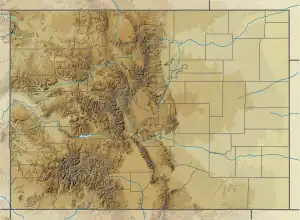| Glencairn Formation | |
|---|---|
| Stratigraphic range: | |
| Type | Formation |
| Unit of | Purgatoire Group |
| Underlies | Dakota Group |
| Overlies | Lytle Formation |
| Thickness | 10–145 feet (3.0–44.2 m) |
| Lithology | |
| Primary | Shale |
| Other | Sandstone |
| Location | |
| Coordinates | 38°31′01″N 104°58′19″W / 38.517°N 104.972°W |
| Region | Colorado New Mexico |
| Country | United States |
| Type section | |
| Named for | Small tract of land north of Lytle, Colorado (sec 2, T17S, R68W) |
| Named by | G.I. Finlay |
| Year defined | 1916 |
 Glencairn Formation (the United States)  Glencairn Formation (Colorado) | |
The Glencairn Formation is a geologic formation found in Colorado[1] and New Mexico.[2] It preserves fossils characteristic of the Albian Age of the Cretaceous Period.[3]
Description
The Glencairn Formation consists of dark gray shale and buff sandstone and siltstone. It disconformably overlies the Lytle Formation, underlies the Dakota Group, and varies in thickness from 10–145 feet (3.0–44.2 m).[1][3] The formation is present from central Colorado[1] to the valley of the Dry Cimarron in northeastern New Mexico.[3] The formation locally contains gypsum veins and gypsum-filled desiccation cracks.[1]
The exposures at the valley of the Dry Cimarron include a basal sandstone bed, the Long Canyon Sandstone Bed, that is up to 3 meters (9.8 ft) thick, is heavily bioturbated, and contains an abundant late Albian invertebrate fossil fauna.[3] This is interpreted as infilling of a drainage system preceding the Kiowa-Skull Creek transgression.[4] It is likely the lateral equivalent of the Tucumcari Shale.[5]
Fossils
The lower beds of the formation are heavily bioturbated and contain abundant fossils of the gryphaeid oyster Texigryphea.[6] The upper beds locally contain petrified plant material.[3] The formation also contains ammonoids, including Goodhallites, Idiohamites, and Engonoceras uddeni, and associated solitary corals, bivalves, and gastropods[7]
History of investigation
The formation was first named as the Glencairn shale member of the now abandoned Purgatoire Formation by G.I. Finlay in 1916, for exposures near Lytle, Colorado.[1] Waage subsequently traced the unit into northeastern New Mexico,[2] where it has been raised to formation rank.[8][3]
References
- 1 2 3 4 5 Finlay, G.I. (1916). "-Description of the Colorado Springs quadrangle, Colorado" (PDF). U.S. Geological Survey Geologic Atlas of the United States Folio. 203. Retrieved 2 September 2020.
- 1 2 Waage, Karl M. (1953). "Refractory clay deposits of south-central Colorado". U.S. Geological Survey Bulletin. 993. doi:10.3133/b993.
- 1 2 3 4 5 6 Ziegler, Kate E.; Ramos, Frank C.; Zimmerer, Matthew J. (2019). "Geology of Northeastern New Mexico, union and Colfax Counties, New Mexico: A Geologic Summary" (PDF). New Mexico Geological Society Field Conference Series. 70 (4): 47–54. Retrieved 1 September 2020.
- ↑ Holbrook, John M.; Dunbar, Robyn Wright (1 July 1992). "Depositional history of Lower Cretaceous strata in northeastern New Mexico: Implications for regional tectonics and depositional sequences". GSA Bulletin. 104 (7): 802–813. Bibcode:1992GSAB..104..802H. doi:10.1130/0016-7606(1992)104<0802:DHOLCS>2.3.CO;2.
- ↑ Scott, R.W.; Holbrook, J.M.; Oboh-Ikuenobe, F.E.; Evetts, M.J.; Benson, D.G.; Kues, B.S. (April 2004). "Middle Cretaceous stratigraphy, southern Western Interior Seaway, New Mexico and Oklahoma". The Mountain Geologist. 41 (2): 33–61. Retrieved 8 September 2020.
- ↑ Kues, B.S. (1987). "Texigryphaea in the Glencarin Formation near Two Buttes, Colorado, with notes on an assemblage of Texigryphaea from the Kiowa Formation of southern Kansas" (PDF). New Mexico Geological Society Field Conference Guidebook. 38: 207–215. Retrieved 2 September 2020.
- ↑ Cobban, William A. (1987). "An ammonoid fauna from the Glencairn Shale Member of the Lower Cretaceous Purgatoire Formation, Baca County, Colorado" (PDF). New Mexico Geological Society Field Conference Guidebook. 38: 217–222. Retrieved 2 September 2020.
- ↑ Kues, B.S.; Lucas, S.G. (1987). "Cretaceous stratigraphy and paleontology in the Dry Cimarron Valley, New Mexico, Colorado, and Oklahoma" (PDF). New Mexico Geological Society Field Conference Guidebook. 38: 167–198. Retrieved 2 September 2020.